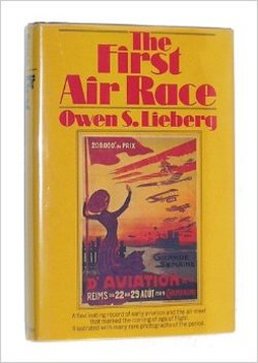 It's 1909 and France is the world center of aviation. The first international air meet is beginning in Reims. Prestigious contests with cash prizes and trophies for best distance, altitude, and speed attract one hundred thousand spectators to Bethany Plain airfield the first day. Industrialists, diplomats, and royalty are arriving for the beginning ceremonies. Mrs. Roosevelt and her children will be here with the American ambassador since the President is occupied with the Panama Canal project. What was it like to be there? Let's pretend that Harry, one of Glenn Curtiss's mechanics, is showing us around. The Venue Mounted dragoons are keeping the lines in order. As we enter the gate we see ornate grandstands, hurriedly built hangars, an aerial race course with pylons at its four corners—and a sea of mud. The truckloads of ashes and stones they brought in last night help a little, but walking in this long skirt is challenging. A colorful poster for the event shows a beautiful mademoiselle and a variety of aeroplanes in flight. Black flags are flying this morning at the top of the pylon flagstaff near the judges' box and near the grandstands. Harry explains. "They can't fly right now due to weather conditions. The shapes and colors of the signal flags tell which competitor is flying, the event, the weather conditions, if a record was made, and if a good landing was made within the rules." "How can they tell when conditions are good for flying?" someone asks. "There are lots of ways. See those cups up there? You can measure the breeze by how fast they go 'round," he says, revolving his right hand for effect. "Some hold a handkerchief at arm's length to see if and how it flutters. And then there's Curtiss's method. He doesn't smoke, but he gives cigars to those who do and then watches how the smoke rises. When it's straight up, it's peak flying weather." The Aeroplanes We notice that there are both biplanes and monoplanes. It's surprising how small they are, most made of wooden sticks, strips of fabric, and piano wire. Harry points to the seat in Louis Bleriot's monoplane, a slender craft of waterproofed fabric, steel tubes, ash and bamboo with a wing span of twenty-five feet. "In this monoplane Bleriot has to crouch low to avoid the elements. In a biplane, the flyer sits bolt upright between the struts. Construction is a do-it-yourself job. They arrive in several packages and then have to be assembled." The Flyers We want to know about the flyers. Harry tells us that twenty-three flyers have registered, but few are experienced. The Wrights won't be here. Instead they are exhibiting their machines in Germany with hopes that the German military, unlike the United States military at this time, will purchase a few Wright aeroplanes. Most wear a business suit, or golf knickers with a stiff high collar. We can easily tell an Anglo from a European. The Anglos are clean shaven while the Europeans sport beards. Many French flyers wear long pointed wax moustaches. "Some are more casual," Harry says as he points to one flyer sporting a cap with the visor turned sportingly to the rear. "They wear goggles, as there's no windshield." The weather improves and one flyer goes onto the field. He is dressed unseasonably warm in a heavy sweater and a leather jacket. Harry reminds us that the man will be quite cold up there, out in the open with nothing between him and the elements. The Competitions Later that day we see some events. They only have to take off, fly a short distance, and land in one piece. For the first time rules have been established for flying contests. Engines aren't reliable enough for a sudden start, so they'll get blocks of time for competition. Anglo-Frenchman Henri Farman comes in stiff and cold after dark, illuminated by automobile headlights. He has to be carried from his machine, but we assume that the $10,000 distance prize will ease his hardship. We leave at the end of the first day, and thank Harry for his time. Later that week, we hear that Curtiss has won the most important contest of the week, The Gordon Bennett Cup, by completing a predetermined two laps of twenty kilometers in the fastest time. Louis Bleriot had been favored to win given his successful English Channel crossing one month earlier. Even the crowd couldn't tell who had won until the announcement. Curtiss won by only six seconds. The prize money is important, but the large Gordon Bennett Cup coming to America is also sweet. Photo: Amazon.com image Sources: Numerous books and on-line sources, including most which are Glenn Curtiss related, report on the 1909 Reims air meet. A good detailed account is The First Air Race by Owen S. Lieberg. Next time: Ford wasn't the only auto maker in the early 1900's
0 Comments
|
Archives
August 2020
Categories
All
|
 RSS Feed
RSS Feed